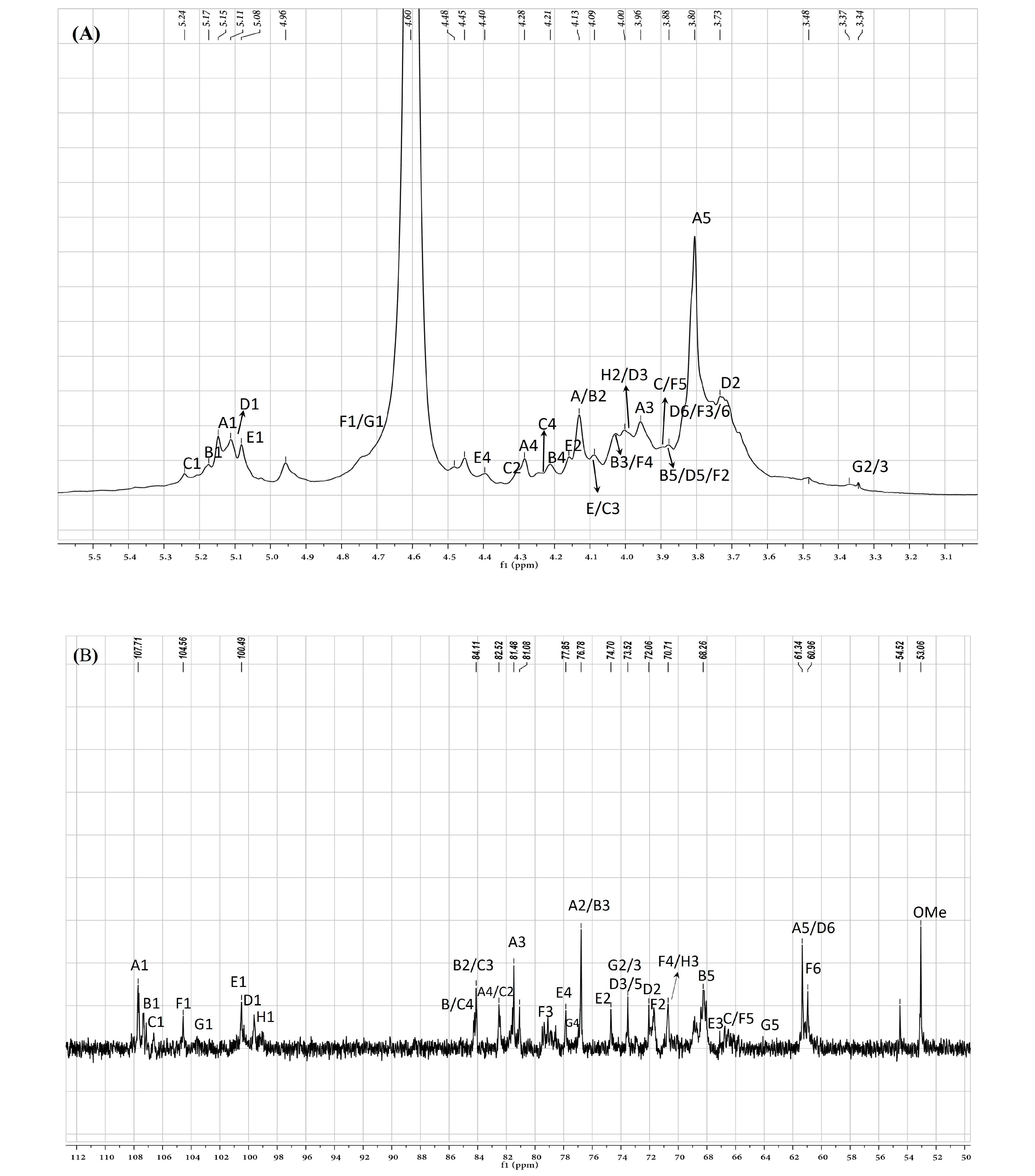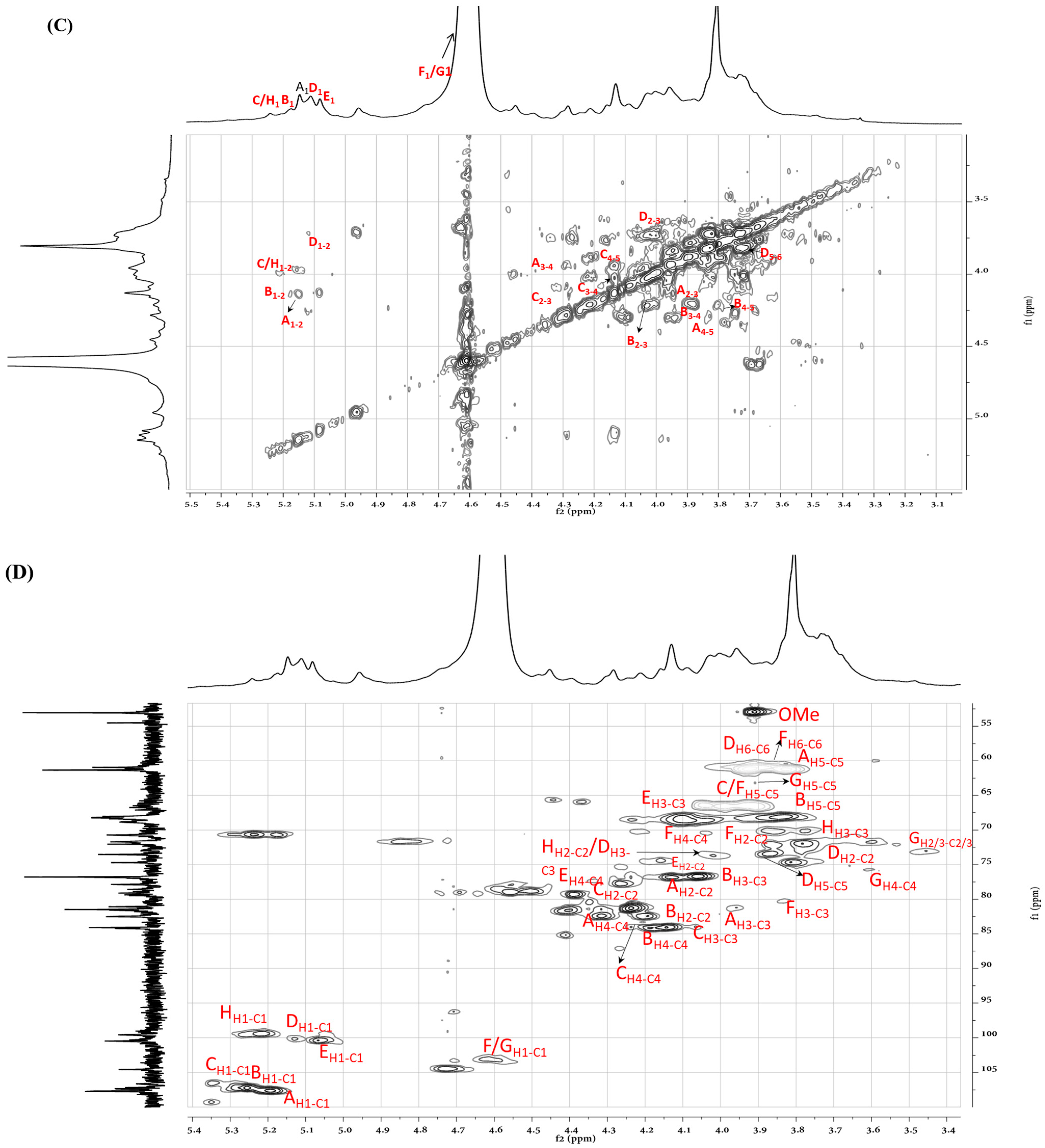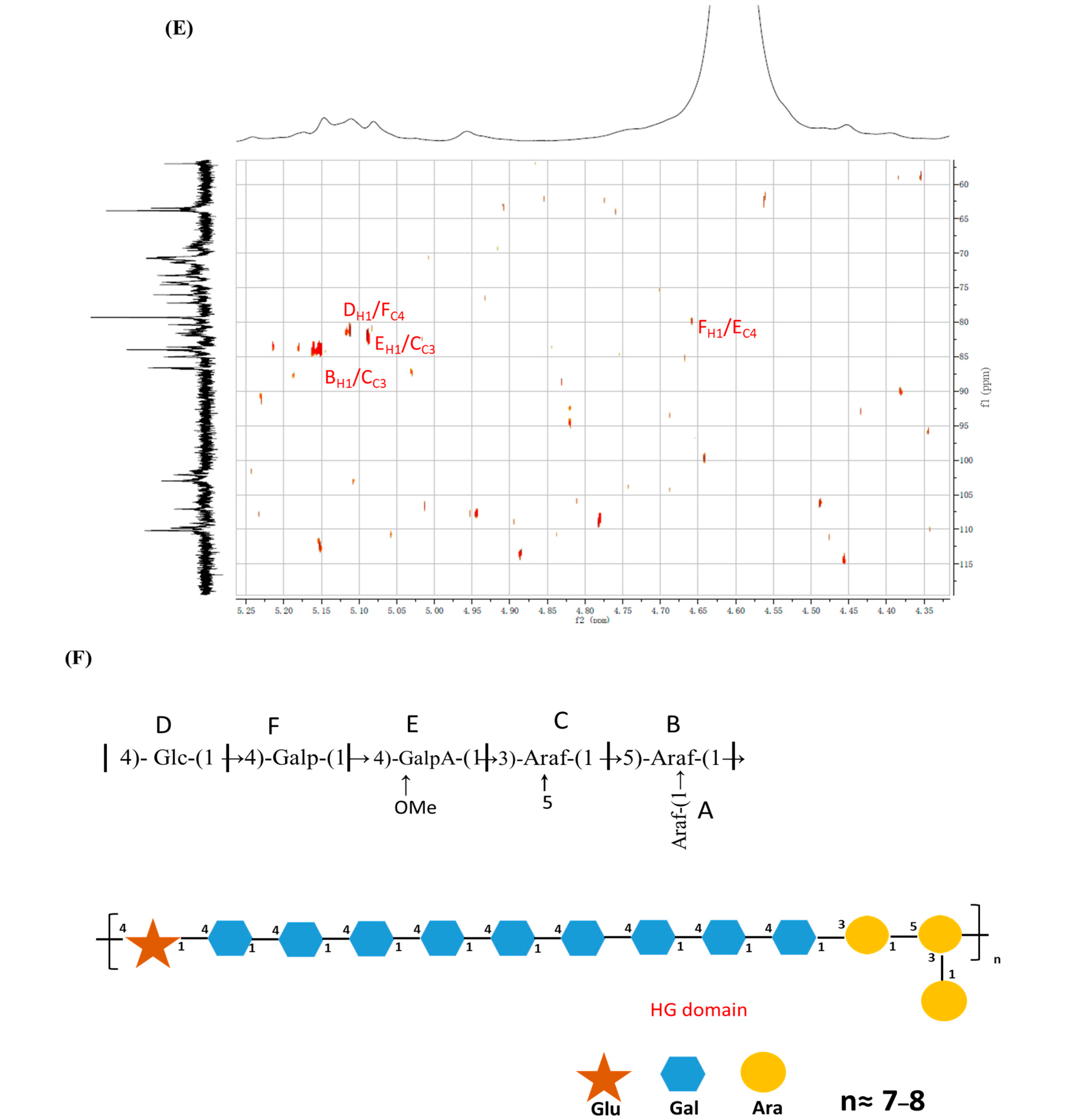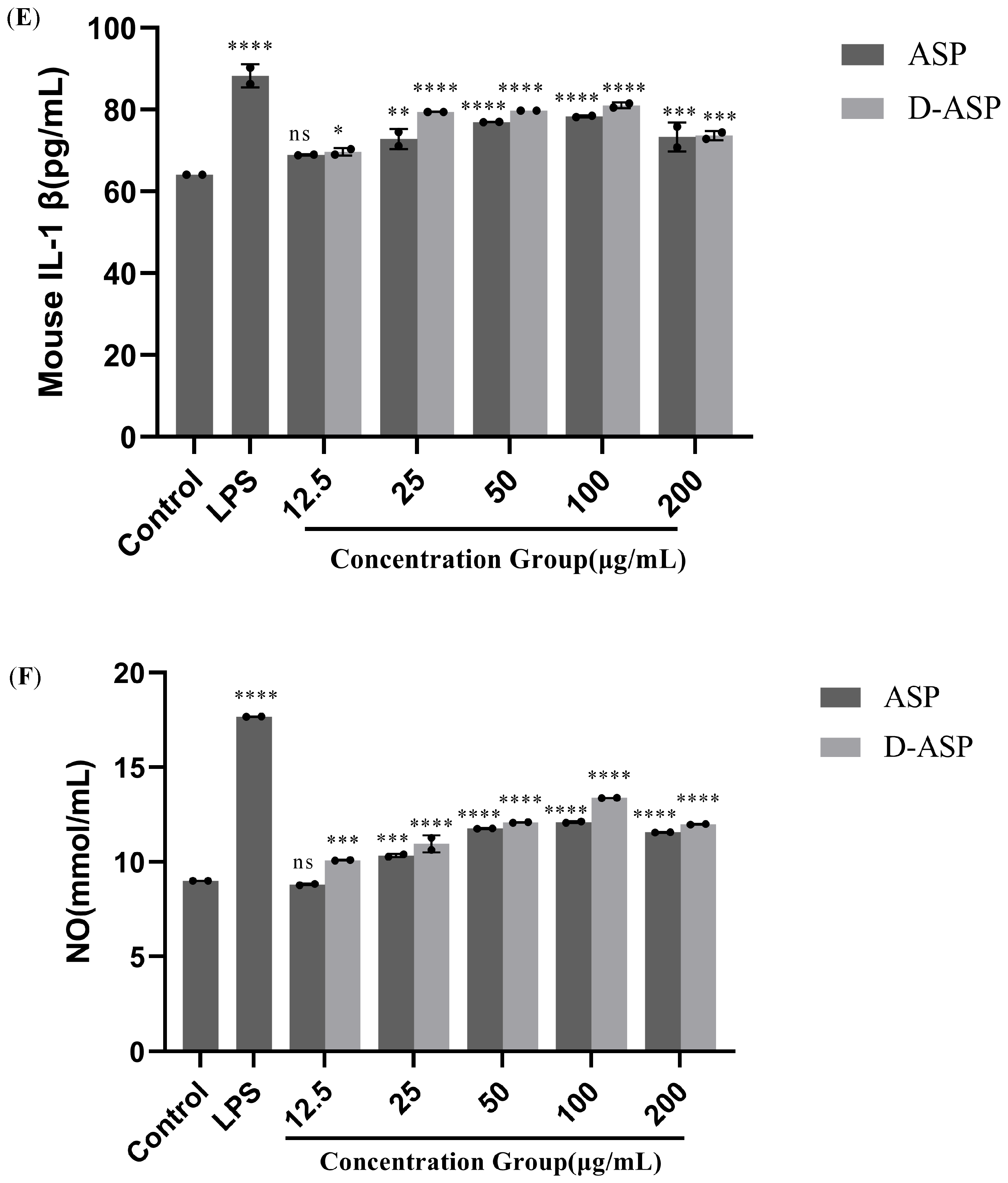A Pectin Polysaccharide from Arnebia szechenyi Kanitz and Its Digestion Product: Physicochemical Properties and Immunostimulatory and Antioxidant Activities
Abstract
1. Introduction
2. Results
2.1. Isolation and Purification of Polysaccharides
2.2. Molecular Weight Determination
2.3. Monosaccharide Composition Analysis
2.4. UV-Vis and FT-IR Spectrum
2.5. Methylation Analysis
2.6. NMR Analysis of ASP
2.7. Determination of a Triple-Helix Structure
2.8. Scanning Electron Microscope
2.9. Antioxidant Activities of ASP and D-ASP
2.10. Immunostimulatory Activities of ASP and D-ASP
3. Discussion
4. Materials and Methods
4.1. Materials and Reagents
4.2. Extraction and Purification of Polysaccharides
4.3. Enzymatic Digestion of ASP Polysaccharide
4.4. Molecular Weight Determination
4.5. Monosaccharide Composition Identification
4.6. Ion Chromatography
4.7. Ultraviolet–Visible (UV-Vis) Spectroscopy Analysis
4.8. Infrared Spectroscopy (FT-IR) Analysis
4.9. Nuclear Magnetic Resonance (NMR) Spectroscopy
4.10. Methylation Analysis
4.11. Determination of a Triple-Helix Structure
4.12. Scanning Electron Microscopy
4.13. Antioxidant Activity of the ASP Polysaccharide and the Digestion Product D-ASP
4.13.1. 2,2-Diphenyl-1-picrylhydrazyl (DPPH*) Radical Scavenging Activity Assay
4.13.2. Superoxide Anion Radical (O2•−) Scavenging Activity
4.13.3. Hydroxyl Radical (OH•) Scavenging Ability
4.14. Immunomodulatory Activity Assay
4.14.1. RAW 264.7 Macrophage Proliferation
4.14.2. Nitric Oxide (NO) Cytokine Production
4.14.3. TNF-α, IL-1β, and IL-6 Cytokine Production
4.14.4. The Phagocytic Activity of RAW 264.7 Cells
4.15. Statistical Analysis
5. Conclusions
Supplementary Materials
Author Contributions
Funding
Data Availability Statement
Acknowledgments
Conflicts of Interest
Abbreviation
| TNF-α | Tumor necrosis factor-alpha |
| IL-6 | Interleukin-6 |
| IL-1β | Interleukin-1β |
| DEAE-52 cellulose | Diethylaminoethyl-cellulose |
| MWCO | Molecular weight cut-off |
| BSA | Bovine serum albumin |
| DPPH | 2,2-diphenyl-1-picrylhydrazyl radical |
| Mw | Weight-average molecular weight |
| O2•− | Superoxide anion radical |
| (OH•) | Hydroxyl radical |
| HPGPC | High-performance gel permeation chromatography |
| IC | Ion chromatography |
| SEM | Scanning electron microscopy |
| IR | Infrared spectroscopy |
| NMR | nuclear magnetic resonance spectroscopy |
| GC-MS | Gas chromatography–mass spectrometry |
| COSY | 1H–1H homonuclear correlation spectroscopy |
| HSQC | 1H–13C heteronuclear single quantum coherence |
| NOESY | Nuclear Overhauser effect spectroscopy |
| HMBC | The long-range heteronuclear multiple bond correlation |
| RG-I | Rhamnogalacturonan-I |
| HG | Homogalacturonan |
| PBS | Phosphate-buffered saline |
| GalA | Galacturonic acid |
| LPS | Lipopolysaccharide |
References
- Liao, M.; Li, A.; Chen, C.; Ouyang, H.; Zhang, Y.; Xu, Y.; Feng, Y.; Jiang, H. Systematic identification of shikonins and shikonofurans in medicinal Zicao species using ultra-high performance liquid chromatography quadrupole time of flight tandem mass spectrometry combined with a data mining strategy. J. Chromatogr. A 2015, 1425, 158–172. [Google Scholar] [CrossRef]
- Chinese Pharmacopoeia Commission. Chinese Pharmacopoeia, 1st ed.; Standards Press of China: Beijing, China, 2015; pp. 340–341. [Google Scholar]
- Wu, Z.; Raven, P.H.; Zhu, G.; Riedl, H.; Kamelin, R. (Eds.) Boraginaceae Flora of China; Science Press: Beijing, China; Missouri Botanical Garden: St. Louis, MO, USA, 2005; pp. 328–329. [Google Scholar]
- Lv, X.J.; Qu, B.; Liu, D.W.; Chen, D.D.; Na, S.S. Content Determination of L–Shikonin and β,β′-Dimethylacrylalkannin in Arnebiae szechenyi Radix from Different Habitats and Study on Its Quality Standard. China Pharm. 2021, 30, 65–70. [Google Scholar] [CrossRef]
- National Administration of Traditional Chinese Medicine; Editorial Board of Chinese Materia Medica. Chinese Materia Medica—Mongolian Medicine Volume; Shanghai Science and Technology Press: Shanghai, China, 2004; pp. 328–329. [Google Scholar]
- Bo, S.; Dan, M.; Li, W.; Zhang, P. Characterizations and immunostimulatory activities of a polysaccharide from Arnebia euchroma (Royle) Johnst. roots. Int. J. Biol. Macromol. 2019, 125, 791–799. [Google Scholar] [CrossRef] [PubMed]
- Xie, L.; Chen, X.; Huang, Z.; Yu, Q.; Chen, Y.; Xiao, J.; Qi, X.; Xie, J. Carboxymethylated and sulfated Cyclocarya paliurus polysaccharides inhibited colon cancer cells growth via PI3K/AKT-MAPKs/NF-κB pathways and immunomodulation. Food Biosci. 2024, 58, 103836. [Google Scholar] [CrossRef]
- Zhang, A.; Wang, J.; Hu, Y.; Qiu, Y.; Dong, C. Polysaccharides play an anti-fibrotic role by regulating intestinal flora: A review of research progress. Int. J. Biol. Macromol. 2024, 271, 131982. [Google Scholar] [CrossRef] [PubMed]
- Huan, C.; Yao, J.; Wang, X.; Zhang, H.; Wang, X.; Jiang, L.; Gao, S. Rehmmannia glutinosa polysaccharide exerts antiviral activity against pseudorabies virus and antioxidant activity. Int. J. Biol. Macromol. 2024, 274, 133455. [Google Scholar] [CrossRef]
- Qiang, M.; Cai, P.; Ao, M.; Li, X.; Chen, Z.; Yu, L. Polysaccharides from Chinese materia medica: Perspective towards cancer management. Int. J. Biol. Macromol. 2023, 224, 496–509. [Google Scholar] [CrossRef]
- Xue, H.; Hao, Z.; Gao, Y.; Cai, X.; Tang, J.; Liao, X.; Tan, J. Research progress on the hypoglycemic activity and mechanisms of natural polysaccharides. Int. J. Biol. Macromol. 2023, 252, 126199. [Google Scholar] [CrossRef] [PubMed]
- Xue, H.; Liang, B.; Wang, Y.; Gao, H.; Fang, S.; Xie, K.; Tan, J. The regulatory effect of polysaccharides on the gut microbiota and their effect on human health: A review. Int. J. Biol. Macromol. 2024, 270, 132170. [Google Scholar] [CrossRef]
- Cheng, X.; Zhu, Y.; Huang, J.; Li, Y.; Jiang, X.; Yang, Q. A neutral polysaccharide from Persicaria hydropiper (L.) Spach ameliorates lipopolysaccharide-induced intestinal barrier injury via regulating the gut microbiota and modulating AKT/PI3K/mTOR and MAPK signaling pathways. J. Ethnopharmacol. 2024, 320, 117403. [Google Scholar] [CrossRef]
- Huang, R.; Yu, H. Extraction methods, chemical compositions, molecular structure, health functions, and potential applications of tea polysaccharides as a promising biomaterial: A review. Int. J. Biol. Macromol. 2024, 277, 134150. [Google Scholar] [CrossRef]
- Zhang, H.; Cui, H.; Xie, F.; Song, Z.; Ai, L. Tamarind seeds polysaccharide: Structure, properties, health benefits, modification and food applications. Food Hydrocoll. 2024, 155, 110222. [Google Scholar] [CrossRef]
- Liu, D.; Tang, W.; Yin, J.-Y.; Nie, S.-P.; Xie, M.-Y. Monosaccharide composition analysis of polysaccharides from natural sources: Hydrolysis condition and detection method development. Food Hydrocoll. 2021, 116, 106641. [Google Scholar] [CrossRef]
- Rosales, T.K.O.; Fabi, J.P. Pectin-based nanoencapsulation strategy to improve the bioavailability of bioactive compounds. Int. J. Biol. Macromol. 2023, 229, 11–21. [Google Scholar] [CrossRef]
- Ding, H.H.; Qian, K.; Goff, H.D.; Wang, Q.; Cui, S.W. Structural and conformational characterization of arabinoxylans from flaxseed mucilage. Food Chem. 2018, 254, 266–271. [Google Scholar] [CrossRef]
- Wu, J.; Wang, H.; Liu, Y.; Xu, B.; Du, B.; Yang, Y. Effect of Ultrasonic Irradiation on the Physicochemical and Structural Properties of Laminaria japonica Polysaccharides and Their Performance in Biological Activities. Molecules 2022, 28, 8. [Google Scholar] [CrossRef]
- He, Z.; He, Y.; Meng, X.; Ge, Z.; Sun, H. Structural characteristics and wound-healing effects of Bletilla striata fresh tuber polysaccharide. Int. J. Biol. Macromol. 2024, 278, 134679. [Google Scholar] [CrossRef] [PubMed]
- Li, C.; Liu, Y.; Zhang, X.; Liu, H.; Zhang, H.; Zhang, X.; Zhang, X.; Ma, X.; Wang, B.; Xue, T.; et al. A novel polysaccharide of Undaria pinnatifida: Structural characterization, carboxymethylation and hypoglycemic activity in vivo. Food Biosci. 2024, 60, 104479. [Google Scholar] [CrossRef]
- Yao, H.-Y.-Y.; Wang, J.-Q.; Yin, J.-Y.; Nie, S.-P.; Xie, M.-Y. A review of NMR analysis in polysaccharide structure and conformation: Progress, challenge and perspective. Food Res. Int. 2021, 143, 110290. [Google Scholar] [CrossRef]
- Yang, Y.; Li, H.; Wang, F.; Jiang, P.; Wang, G. An arabinogalactan extracted with alkali from Portulaca oleracea L. used as an immunopotentiator and a vaccine carrier in its conjugate to BSA. Carbohydr. Polym. 2023, 316, 120998. [Google Scholar] [CrossRef] [PubMed]
- Chen, J.; Pang, W.; Shi, W.; Yang, B.; Kan, Y.; He, Z.; Hu, J. Structural Elucidation of a Novel Polysaccharide from Pseudostellaria heterophylla and Stimulating Glucose Uptake in Cells and Distributing in Rats by Oral. Molecules 2019, 21, 1233. [Google Scholar] [CrossRef]
- He, F.; Zhang, S.; Li, Y.; Chen, X.; Du, Z.; Shao, C.; Ding, K. The structure elucidation of novel arabinogalactan LRP1-S2 against pancreatic cancer cells growth in vitro and in vivo. Carbohydr. Polym. 2021, 267, 118172. [Google Scholar] [CrossRef]
- Maity, G.N.; Maity, P.; Dasgupta, A.; Acharya, K.; Dalai, S.; Mondal, S. Structural and antioxidant studies of a new arabinoxylan from green stem Andrographis paniculata (Kalmegh). Carbohydr. Polym. 2019, 212, 297–303. [Google Scholar] [CrossRef]
- Zheng, Y.; Du, J.; Wang, Y.; Wang, W.W.; An, X.P.; Qi, J.W. Unlocking dandelion (Taraxacum mongolicum)’s hidden treasure: Enzyme-hydrolyzed polysaccharides with enhanced bioactivity for ROS defense and developmental protection. Chem. Biol. Technol. Agric. 2025, 12, 103. [Google Scholar] [CrossRef]
- Li, X.-J.; Xiao, S.-J.; Xie, Y.H.; Chen, J.; Xu, H.-R.; Yin, Y.; Zhang, R.; Yang, T.; Zhou, T.-Y.; Zhang, S.-Y.; et al. Structural characterization and immune activity evaluation of a polysaccharide from Lyophyllum Decastes. Int. J. Biol. Macromol. 2024, 278, 134628. [Google Scholar] [CrossRef] [PubMed]
- Baverel, V.; Garrido, C.; Kohli, E. Intracellular complement in mono cytes and macrophages: Emerging roles. Curr. Opin. Immunol. 2025, 96, 102629. [Google Scholar] [CrossRef]
- De Amici, M.; Puggioni, F.; Casali, L.; Alesina, R. Variations in serum levels of interleukin (IL)-1beta, IL-2, IL-6, and tumor necrosis factor-alpha during specific immunotherapy. Annals of allergy, asthma & immunology: Official publication of the American College of Allergy. Asthma Immunol. 2001, 86, 311–313. [Google Scholar] [CrossRef]
- Weber, R.; Groth, C.; Lasser, S.; Arkhypov, I.; Petrova, V.; Altevogt, P.; Utikal, J.; Umansky, V. IL-6 as a major regulator of MDSC activity and possible target for cancer immunotherapy. Cell. Immunol. 2021, 359, 104254. [Google Scholar] [CrossRef]
- Yang, Q.; Huang, M.; Cai, X.; Jia, L.; Wang, S. Investigation on activation in RAW264.7 macrophage cells and protection in cyclophosphamide-treated mice of Pseudostellaria heterophylla protein hydrolysate. Food Chem. Toxicol. 2019, 134, 110816. [Google Scholar] [CrossRef]
- Ridley, B.L.; O’Neill, M.A.; Mohnen, D. Pectins: Structure, biosynthesis, and oligogalacturonide-related signaling. Phytochemistry 2001, 57, 929–967. [Google Scholar] [CrossRef] [PubMed]
- Schols, H.A.; Voragen, A.G.J. Complex pectins: Structure elucidation using enzymes. Biotechnol. Prog. 1996, 14, 3–19. [Google Scholar]
- Jin, M.Y.; Li, M.Y.; Huang, R.M.; Wu, X.Y.; Sun, Y.M.; Xu, Z.L. Structural features and anti-inflammatory properties of pectic polysaccharides: A review. Trends Food Sci. Technol. 2021, 107, 284–298. [Google Scholar] [CrossRef]
- Wang, D.; Li, H.; Li, B.; Ma, R.; Zhang, N.; Zhang, X.; Jiao, L.; Wu, W. Systematic fractionation and immunoenhancement of water-soluble polysaccharides isolated from fruit of Morus alba L. Int. J. Biol. Macromol. 2018, 116, 1056–1063. [Google Scholar] [CrossRef]
- Kim, S.M.; Shin, H.Y.; Sim, S.H.; Rho, Y.K.; Yu, K.W.; Shin, K.S. Effects of pectin-type polysaccharides derived from houttuynia cordata on the intestinal immune system in native c3h/hen mice. Int. J. Biol. Macromol. 2025, 309, 142995. [Google Scholar]
- Zeng, C.; Ye, G.; Li, G.; Cao, H.; Wang, Z.; Ji, S. RID serve as a more appropriate measure than phenol sulfuric acid method for natural water-soluble polysaccharides quantification. Carbohydr. Polym. 2022, 278, 118928. [Google Scholar] [CrossRef]
- Bo, S.; Dan, M.; Han, W.; Ochir, S.; Bao, L.; Liu, L.; Muschin, T.; Baigude, H. Physicochemical properties, immunostimulatory and antioxidant activities of a novel polysaccharide isolated from Mirabilis himalaica (Edgew) Heim. RSC Adv. 2022, 12, 17264–17275. [Google Scholar] [CrossRef]
- Li, J.; Deng, Q.; Yu, X.; Wang, W. Structural studies of a new fraction obtained by gradient ethanol precipitation from Acacia seyal gum. Food Hydrocoll. 2020, 107, 105932. [Google Scholar] [CrossRef]
- Wang, Z.-J.; Xie, J.-H.; Shen, M.-Y.; Tang, W.; Wang, H.; Nie, S.-P.; Xie, M.-Y. Carboxymethylation of polysaccharide from Cyclocarya paliurus and their characterization and antioxidant properties evaluation. Carbohydr. Polym. 2016, 136, 988–994. [Google Scholar] [CrossRef] [PubMed]
- Zhang, M.; Zhao, P.; Ochir, S.; Bai, W.; Lu, J.; Dan, M.; Bo, S.; Chen, C. Sulfated modification, characterizations, anti-oxidant and immunostimulatory activities of a polysaccharide from Arnebia euchroma (Royle) Johnst. Roots. Results Chem. 2025, 17, 102624. [Google Scholar] [CrossRef]
- Gulcin, İ. Antioxidants and antioxidant methods: An updated overview. Arch. Toxicol. 2020, 94, 651–715. [Google Scholar] [CrossRef]
- Fernandes, P.A.; Coimbra, M.A. The antioxidant activity of polysaccharides: A structure-function relationship overview. Carbohydr. Polym. 2023, 314, 120965. [Google Scholar] [CrossRef] [PubMed]
- Chen, N.; Jiang, T.; Xu, J.; Xi, W.; Shang, E.; Xiao, P.; Duan, J.-A. The relationship between polysaccharide structure and its antioxidant activity needs to be systematically elucidated. Int. J. Biol. Macromol. 2024, 270, 132391. [Google Scholar] [CrossRef] [PubMed]
- Li, H.; Li, J.; Shi, H.; Li, C.; Huang, W.; Zhang, M.; Luo, Y.; Song, L.; Yu, R.; Zhu, J. Structural characterization and immunoregulatory activity of a novel acidic polysaccharide from Scapharca subcrenata. Int. J. Biol. Macromol. 2022, 210, 439–454. [Google Scholar] [CrossRef] [PubMed]














| RT | Methylated Sugar | Mass Fragments (m/z) | Molar Ratio | Type of Linkage |
|---|---|---|---|---|
| 16.572 | 2,3,5-Me3-Araf | 43, 71, 87, 101, 117, 129, 145, 161 | 0.108 | Araf-(1→ |
| 22.009 | 2,3-Me2-Araf | 43, 71, 87, 99, 101, 117, 129, 161, 189 | 0.127 | →5)-Araf-(1→ |
| 26.135 | 2-Me1-Araf | 43, 58, 85, 99, 117, 127, 159, 201 | 0.013 | →3,5)-Araf-(1→ |
| Arabinose | 0.248 | |||
| 20.45 | 2,4-Me2-Xylp | 43, 58, 85, 99, 101, 117, 127, 159, 173 | 0.014 | →3)-Xylp-(1→ |
| 22.341 | 2,3-Me2-Xylp | 43, 71, 87, 99, 101, 117, 129, 161, 189 | 0.026 | →4)-Xylp-(1→ |
| Xylose | 0.040 | |||
| 24.281 | 2,3,4,6-Me4-Glcp | 43, 71, 87, 101, 117, 129, 145, 161, 205 | 0.036 | Glcp-(1→ |
| 31.342 | 2,3,4-Me3-Glcp | 43, 87, 99, 101, 117, 129, 161, 189, 233 | 0.009 | →6-Glcp-(1→ |
| 34.183 | 2,6-Me2-Glcp | 43, 87, 97, 117, 159, 185 | 0.030 | →3,4)-Glcp-(1→ |
| 37.16 | 2,3-Me2-Glcp | 43, 71, 85, 87, 99, 101, 117, 127, 159, 161, 201 | 0.042 | →4,6)-Glcp-(1→ |
| Glucose | 0.117 | |||
| 25.392 | 2,3,4,6-Me4-Galp | 43, 71, 87, 101, 117, 129, 145, 161, 205 | 0.013 | Galp-(1→ |
| 29.645 | 2,3,6-Me3-Galp | 43, 87, 99, 101, 113, 117, 129, 131, 161, 173, 233 | 0.229 | →4)-GalAp-(1→ |
| 30.114 | 2,3,6-Me3-Galp | 43, 87, 99, 101, 113, 117, 129, 131, 161, 173, 233 | 0.128 | →4)-Galp-(1→ |
| 37.659 | 2,3-Me2-Galp | 43, 71, 85, 87, 99, 101, 117, 127, 159, 161, 201, 261 | 0.009 | →4,6)-Galp-(1→ |
| 39.474 | 2,4-Me2-Galp | 43, 87, 117, 129, 159, 189, 233 | 0.018 | →3)-Galp-(1→ |
| 41.723 | 3-Me1-Galp | 43, 87, 99, 127, 129, 189, 201, 261 | 0.008 | →2,4,6)-Galp-(1→ |
| Galactose | 0.405 |
| No. | Type of Linkage | Proton or Carbon (1H/13C, ppm) | |||||||
|---|---|---|---|---|---|---|---|---|---|
| H1/C1 | H2/C2 | H3/C3 | H4/C4 | H5/C5 | H6/C6 | Ref. | |||
| A | Araf-(1→ | 5.14/107.7 | 4.13/76.8 | 3.96/81.5 | 4.23/82.4 | 3.80/61.34 | --- | [22] | |
| B | →5)-Araf-(1→ | 5.17/107.3 | 4.13/82.41 | 4.09/76.8 | 4.22/84.1 | 3.87/68.3 | --- | [18] | |
| C | →3,5)-Araf-(1→ | 5.24/107.1 | 4.30/82.5 | 4.09/84.3 | 4.13/84.3 | 3.90/66.5 | ---- | [23] | |
| D | →4)-Glcp-(1→ | 5.12/100.2 | 3.71/71.9 | 4.00/73.5 | -- | 3.67/63.02 | 3.88/61.5 | [24] | |
| E | 1→4)-GalpA-(6-OMe)- | 5.03/100.5 | 3.62/71.53 | 3.82/68.2 | 4.29/79.0 | 4.53/78.6 | n.d./171.0 | 3.88/53.03(-OMe) | [25] |
| F | →3or 4)-Galp-(1→ | 4.60/103.1 | 3.80/72.9 | 3.73/74.8 | 3.83/80.5 | 4.03/73.53 | 3.87/61.34 | [26] | |
| G | →4)-Xylp-(1→ | 4.58/103.2 | 3.39/72.9 | 4.48/73.1 | 3.58/75.7 | 3.91/63.2 | [18] | ||
Disclaimer/Publisher’s Note: The statements, opinions and data contained in all publications are solely those of the individual author(s) and contributor(s) and not of MDPI and/or the editor(s). MDPI and/or the editor(s) disclaim responsibility for any injury to people or property resulting from any ideas, methods, instructions or products referred to in the content. |
© 2025 by the authors. Licensee MDPI, Basel, Switzerland. This article is an open access article distributed under the terms and conditions of the Creative Commons Attribution (CC BY) license (https://creativecommons.org/licenses/by/4.0/).
Share and Cite
Bo, S.; Zhao, P.; Ochir, S.; Pang, H.; Dan, M.; Bai, W.; Zhang, M.; Lu, J. A Pectin Polysaccharide from Arnebia szechenyi Kanitz and Its Digestion Product: Physicochemical Properties and Immunostimulatory and Antioxidant Activities. Molecules 2025, 30, 3852. https://doi.org/10.3390/molecules30193852
Bo S, Zhao P, Ochir S, Pang H, Dan M, Bai W, Zhang M, Lu J. A Pectin Polysaccharide from Arnebia szechenyi Kanitz and Its Digestion Product: Physicochemical Properties and Immunostimulatory and Antioxidant Activities. Molecules. 2025; 30(19):3852. https://doi.org/10.3390/molecules30193852
Chicago/Turabian StyleBo, Surina, Peng Zhao, Sarangua Ochir, Huiwen Pang, Mu Dan, Wenming Bai, Man Zhang, and Jingkun Lu. 2025. "A Pectin Polysaccharide from Arnebia szechenyi Kanitz and Its Digestion Product: Physicochemical Properties and Immunostimulatory and Antioxidant Activities" Molecules 30, no. 19: 3852. https://doi.org/10.3390/molecules30193852
APA StyleBo, S., Zhao, P., Ochir, S., Pang, H., Dan, M., Bai, W., Zhang, M., & Lu, J. (2025). A Pectin Polysaccharide from Arnebia szechenyi Kanitz and Its Digestion Product: Physicochemical Properties and Immunostimulatory and Antioxidant Activities. Molecules, 30(19), 3852. https://doi.org/10.3390/molecules30193852







